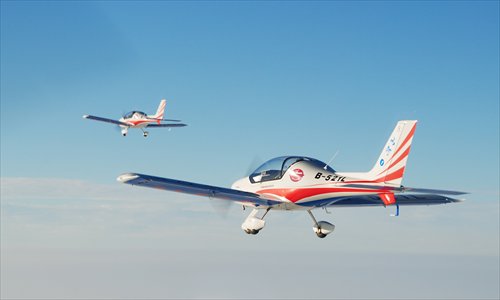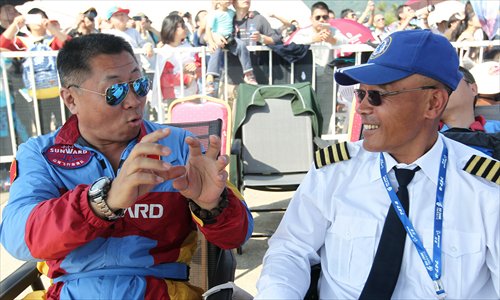A pilot scheme
China’s first civil aeronatic team seeks to promote private aviation

Two Aurora SA60L light aircraft are seen during their flight from Zhuzhou, Hunan Province to Zhuhai, Guangdong Province on November 6 to attend the airshow. Photo: courtesy of Hunan Sunward Science and Technology
Lin Hong, a former fighter pilot, beamed as he watched the sleek J-10 fighter jets roar across the sky to rapturous applause from the crowds at the 10th China International Aviation and Aerospace Exhibition in Zhuhai, Guangdong Province on November 14.
"I feel proud of the younger generation and I envy them for being able to fly such a good fighter," he told the Global Times at the event, which was also known as Airshow China.
Lin, a commercial pilot in his 50s, used to be a member of the Chinese military's Bayi Aerobatic Team. At the time, he only got to fly a Chinese J-7 fighter jet made in the 1960s.
Years later, the suntanned Lin says that his successors put on a better show than he did.
He got to show off his skills at this year's Airshow China, not in a fighter jet, but in an Aurora SA60L two-seat light sports aircraft along with three other members of the Sunward Aerobatic Team, the first Chinese civil aerobatic team that flies domestically-made aircraft.
The audience may just see Lin's team's performance as a simple presentation of sports aircraft. However the foundation of the Sunward Aerobatic Team has been seen by some as an important moment in the development of China's civil aviation sector, a field which may have a bright future as the country's airspace gradually becomes more open.
New team, old hands
Founded in August by the Hunan Sunward Science and Technology Company, the Sunward Aerobatic Team made its debut at Airshow China this year, after some of its pilots flew solo in the last two exhibitions. With six team members born in various decades, ranging from the 1960s to the 1990s, the team has been nicknamed Team 6789.
There is a growing demand for aerobatic teams to perform at aviation exhibitions in China, which now has more than a dozen air shows every year. This is a big increase from the few that were put on in the past, according to Hou Min, team captain and one of the deputy directors of the Aircraft Owners and Pilots Association of China's experimental aircraft committee.
"Aerobatic performance is one of the major attractions at those exhibitions, but it can cost millions of yuan to bring aerobatic teams from overseas. Many Chinese pilots have been wondering if they are able to get a piece of the pie and we have proven that China's home grown planes can do the job and that [Chinese pilots] can do it too," Hou told the Global Times.
Also a former member of the People's Liberation Army (PLA) Air Force, Hou selected five other pilots to join him in the team from a pool of around 20 applicants.
Hou said that there are a number of older former PLA Air Force members working in the general aviation industry at present that can contribute to the development of the industry. "We can't rely on young pilots for now," he added.
When flying in formation, the jets fly with only five meters of air between the rudder of the plane in front and the propeller of the plane behind, and with only three meters between the tips of their wings. Flying this close is incredibly challenging.
"Sometimes plane No.3, which two of our young pilots under 40 years old take turns piloting, will lag behind. They are quite experienced and have flown for many hours, but the turbulence in the air makes them nervous," Hou explained.
"Compared to a jet fighter, a sports aircraft with a propeller is much lighter and even a little turbulence can have a much bigger impact on an Aurora than on a J-7," Lin added.
It took both Lin and Hou a while to adapt to civilian aircraft after they left the forces.
"To put it simply, it feels like riding a bicycle when you used to ride a motorcycle. But it also places less demands on your body. Military pilots suffer from severe physical stress as their body has to cope with the pressure of about seven times their own weight during sudden maneuvers," Lin explained.
"As a former pilot with the PLA Air Force, I feel obliged to take this opportunity to give a helping hand to the development of civil aviation in China," Lin said.

Hou Min (left) and Lin Hong of the Sunward Aerobatic Team discuss their performance. Photo: Cui Meng/GT
Opportunities for private aircraft
The State Council and military authorities jointly decided to open up the country's low-altitude airspace to general aviation in November 2010, however the process of bringing this decision into force has taken several years.
Low-altitude airspace refers to a flying height of between 100 meters and 1,000 meters above the ground.
The Civil Aviation Administration of China (CAAC) is expected to open low-altitude airspace nationwide, aside from some restricted areas, by 2015.
According to Liu Zengyu, an official with the CAAC, there are currently 229 general aviation companies in China and another 198 enterprises are in the process of being established.
The number of registered civilian aircraft in China is 1,786, but the CAAC estimates that this number will rise to 50,000 in the future. This will mean the total market value of the civil aviation sector will be 3,000 billion yuan ($490 billion), Liu said.
"There is a huge gap between China and the US, where the number of registered private aircraft is around 200,000. Apart from a stronger consumption capability, there is also a huge demand for this in China, including for logistical and emergency rescue purposes," Ma Yuzhong, a marketing manager at a general aviation company that he prefers not be named.
"Most new pilots get their licenses for commercial purposes instead of for entertainment. What we seek to do now is to break new ground so that others can see more potential in flying for recreation. I'm pretty sure there will be more civil aerobatic teams in China in 2016," Hou noted, adding that several general aviation companies have expressed their intention to establish teams.
With airspace now strictly controlled by the PLA Air Force and the CAAC, private aircraft in China have to request approval before taking off and deal with practical problems when landing, including a small number of airports and service professionals on the ground.
Analysts working at China Galaxy Securities believe that the development of general aviation will primarily take the form of the construction of basic infrastructure, after restrictive airspace policies are lifted, as this should be strengthened to improve services and decrease the costs of further promoting this new industry, reported the Xinhua News Agency.